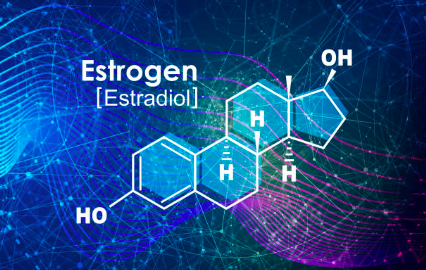You and Estradiol

Do you know Estradiol?
You know about estrogen, but did you know there are different forms of it?
Estradiol is a form of estrogen and plays a critical role in the reproductive and sexual functioning of women. It, along with progesterone, is one of the primary female sex hormones. Estradiol is synthesized primarily in the ovaries, but also in other tissues such as the adrenal glands and the placenta during pregnancy.
Estradiol is a form of estrogen and plays a critical role in the reproductive and sexual functioning of women. It, along with progesterone, is one of the primary female sex hormones. Estradiol is synthesized primarily in the ovaries, but also in other tissues such as the adrenal glands and the placenta during pregnancy.
What does Estradiol do for us?
Estradiol is important for:
1️⃣ Reproductive Health: Estradiol regulates the menstrual cycle and is essential for the development of the reproductive system, including the growth of the uterus, fallopian tubes, and vagina. It also prepares the endometrium for the potential implantation of a fertilized egg.
2️⃣ Bone Health: It helps maintain bone density and strength, playing a protective role against osteoporosis and bone fractures in postmenopausal women, as natural estrogen levels decline significantly during this period.
3️⃣ Cardiovascular Health: Estradiol has a beneficial effect on the inner layer of arterial blood vessels, helping to maintain their flexibility and promoting better blood flow; it also impacts cholesterol levels, promoting higher HDL (“good” cholesterol) and lower LDL (“bad” cholesterol).
4️⃣ Skin and Hair: It can have a positive effect on skin and hair, contributing to their health and appearance by increasing skin thickness and elasticity and supporting scalp hair growth.
5️⃣ Mood and Cognitive Function: Estrogen has been found to have a positive influence on mood and may help in reducing symptoms of depression and anxiety. Additionally, there’s evidence to suggest that it might contribute to cognitive health, potentially providing some protection against cognitive decline with aging, although findings are mixed.
6️⃣ Menopause Management: Estradiol is often used in hormone replacement therapies to alleviate symptoms of menopause, such as hot flashes, night sweats, vaginal dryness, and mood swings, by replacing the declining natural hormones.
7️⃣ Sexual Function: It helps to maintain the health of vaginal tissue and other reproductive organs, which allows for comfortable and pleasurable sexual activity.
You need to know your estradiol levels. If an imbalance is detected, taking the appropriate steps immediately can improve your health and how you feel each day. Keeping track of the symptoms you are experiencing will assist in getting the correct diagnosis and treatment.
What are the symptoms and causes of low estradiol?
Symptoms:
👉 Irregular Menstrual Periods: Skipped periods or irregular cycles.
👉 Hot Flashes and Night Sweats: Sudden feelings of heat, especially common during menopause.
👉 Mood Swings: Increased anxiety, depression, or irritability.
👉 Sleep Disturbances: Difficulty falling asleep or staying asleep.
👉 Decreased Libido: Reduced sex drive or sexual dysfunction.
👉 Dry Skin or Thinning Hair: Changes in skin texture or hair loss.
👉 Fatigue: Persistent tiredness and lack of energy.
👉 Vaginal Dryness: Discomfort during intercourse and other vaginal health issues.
👉 Weak Bones (Osteoporosis): Reduced bone density leads to frail bones and increased risk of fractures.
👉 Trouble Concentrating: Difficulty in focusing or memory problems.
👉 Weight Gain: Unexplained weight changes, especially increased fat around the abdomen.
👉 Headaches or Migraine: New or worsening patterns of headaches.
Causes:
➡️ Menopause: The natural decline in reproductive hormones when a woman reaches her 40s or 50s.
➡️ Ovarian Failure or Insufficiency: Premature menopause or diminished functioning of the ovaries.
➡️ Hypopituitarism: Poor functioning of the pituitary gland can lead to a decrease in the hormones that stimulate estrogen production.
➡️ Eating Disorders/Inconsistency: Conditions such as anorexia or bulimia can disrupt hormone levels as well as chronic under-eating in general.
➡️ Excessive Exercise: Intense physical activity can cause menstrual irregularities and decrease estrogen.
➡️ Chronic Kidney Disease: Can disrupt hormone balance.
➡️ Low Body Fat Percent: Body fat plays a role in estrogen production, and too little body fat can decrease estradiol levels.
➡️ Chemotherapy and Radiation Therapy: Cancer treatments can damage the ovaries and reduce hormone production.
➡️ Certain Medications: Some drugs, such as aromatase inhibitors, can lower estrogen levels as a side effect.
➡️ Genetic Disorders: Such as Turner syndrome or other chromosomal abnormalities.
What are the symptoms and causes of elevated estrogen?
Symptoms:
👉 Menstrual Problems: Heavy periods, severe PMS, irregular cycles, or fibroids
👉 Mood Swings and Depression: Fluctuations in hormone levels can affect mood regulation
👉 Weight Gain: Especially in the hips, thighs, and midsection
👉 Fatigue: Chronic tiredness that isn’t alleviated by sleep
👉 Breast Changes: Tenderness, swelling, or fibrocystic changes
👉 Low Libido: Hormonal imbalance can lead to a decrease in sexual desire
👉 Hair Loss: Changes in hair density or texture
👉 Sleep Disturbances: Difficulty falling or staying asleep
👉 Memory and Cognitive Issues: Foggy thinking or memory lapses
👉 Skin Changes: Acne or other skin issues.
Causes:
➡️ Excess Body Fat: Adipose tissue produces estrogen, meaning that more body fat can lead to higher levels of estrogen in the body.
➡️ Stress: Chronic stress can lead to adrenal gland fatigue, which may disrupt hormone balance.
➡️ Poor Diet: Diets high in processed foods, sugar, and processed foods may lead to hormone imbalances.
➡️ Xenoestrogens: Exposure to these chemicals found in plastics, personal care products, and pesticides can mimic estrogen in the body.
➡️ Impaired Liver Function: The liver metabolizes estrogen, so liver dysfunction can lead to elevated estrogen levels.
➡️ Gut Health Issues: A healthy gut helps eliminate excess estrogen; dysbiosis (imbalance of the gut bacteria) can impair this process.
➡️ Impaired Estrogen Detoxification: Genetic variations can affect how well the body detoxifies and excretes estrogen.
➡️ Hormone Replacement Therapy (HRT) / Birth Control: Exogenous hormones can contribute to estrogen dominance.
Diagnosis and Treatment
Diagnosis of disparate levels of estradiol can be as simple as getting a comprehensive set of blood labs. I use Life Extension for all my clients; it is quick, easy, and inexpensive.
I have suggested using a DUTCH (Dried Urine Test for Comprehensive Hormones) for some of my clients. This test gives us a more comprehensive look at how your hormones are functioning, being detoxified, and your stress markers.
To determine which test is appropriate for you, we gather an extensive list of symptoms paired with your lifestyle factors and previous doctor’s observations and physical exams.
Treatment of estradiol issues depends on the cause…
However…addressing your underlying health issues is our first course of action. We do this by modifying the lifestyle factors that may be contributing to your issues, which may include:
✅ Nutritional adjustments
✅ Exercise modifications
✅ Sleep improvement
✅ Stress management
✅ Supplementation
✅ Possible referral for HRT (Hormone Replacement Therapy)
Your sex hormones directly impact all areas of your health and well-being, not just your ability to have children. If you want to live a long, healthy life free from disease and medications, you need to get your labs done every year and know all your hormone levels. That data can help you make important, healthy choices every day.





